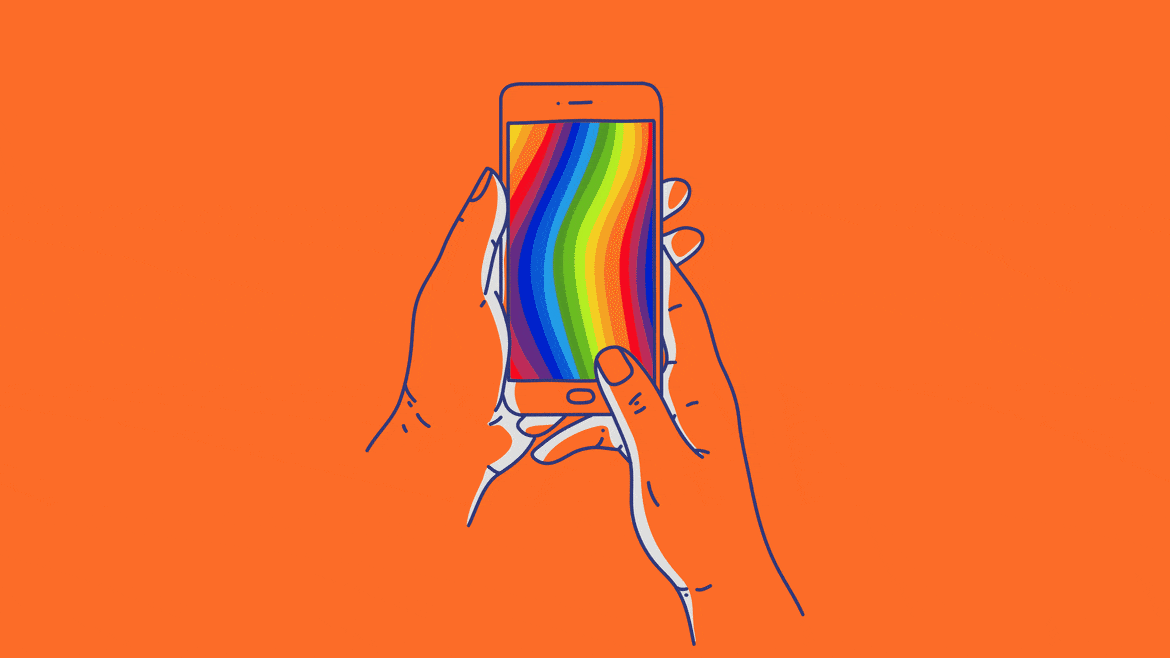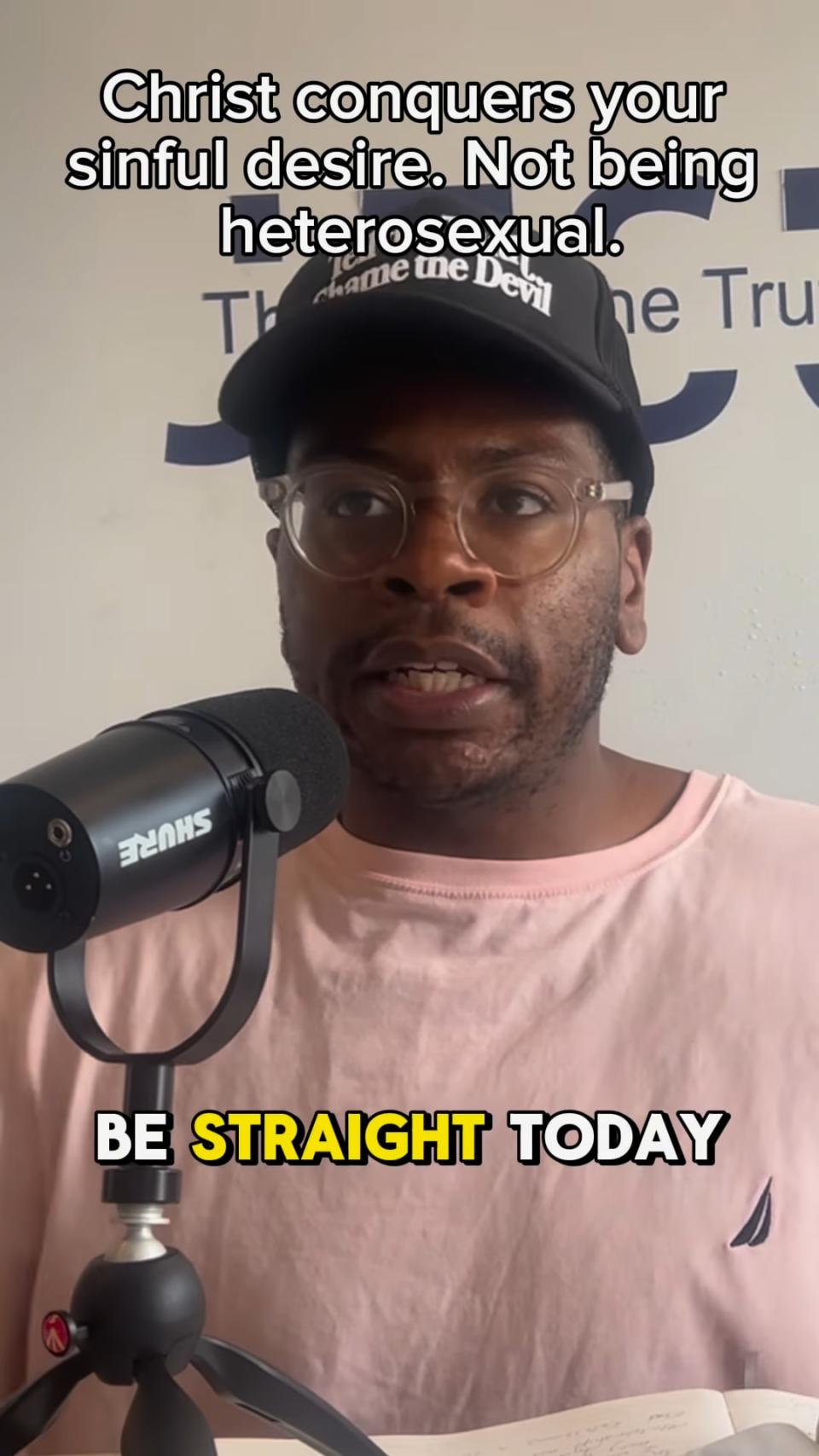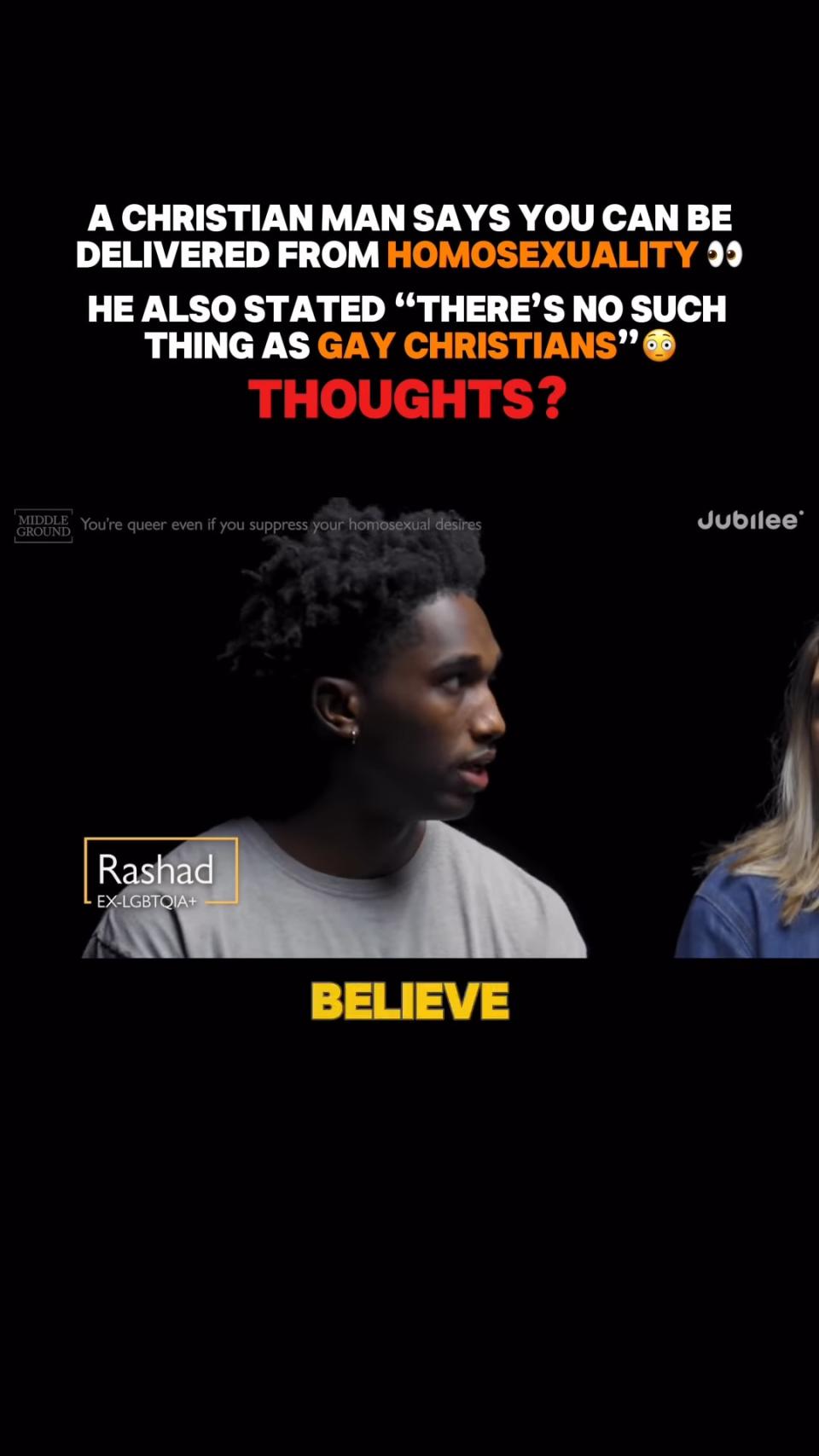TikTok Is Flooding Gen Z With Conversion Therapy Propaganda

There is little subtlety to the TikTok videos posted by Samuel A. Perez, self-described “Former Gay Stripper Now Child Of God.” One of his most popular clips, with more than 1.2 million views, is captioned: “When I used to be gay but discovered Jesus is better than my sexuality.” Set to a pumping viral beat, it shows Perez examining what looks like a well-thumbed book of scripture before declaring with a smile: “Switching sides!”
Thousands upon thousands of positive messages flood the comments section. “Welcome to the Family brother!✝️✝️🙏🙏” and “Holy glow up✝️” and “yessss. Same!”
Make-up, pink wigs, and bunny ears are a staple of Perez’s videos, leaving some commenters unsure if the posts are an attempt at satire or a skit. “wait I didn't realize you were serious 💀 I THOUGHT THIS WAS A JOKE NGL😦,” reads one comment on a recent Instagram video.
Well, I’m not gonna lie either: THIS IS NOT A JOKE.
When Perez posts to his over 75,000 followers on TikTok, he appears deadly serious about his efforts to enlist God’s help in overcoming his same-sex attraction—or SSA, a popular phase in the ‘ex-gay’ lexicon. According to his website, he wants to support others who also “struggle with SSA find comfort and encouragement towards an all encompassing and consuming love in Jesus Christ.”
Dozens of messages from young people can be seen in the comments section, begging for help to learn how to stop their own same-sex attraction. “I love god but how does that work- bro teach me 😭 I am bi I’m mad at my gay side,” one reader pleads.
Conversion therapy 2.0
With a new wave of younger, digital-native influencers, the long-discredited “ex-gay” movement—which first surfaced in the 1970s and peaked in the 1990s only to fall away in the early 2000s—is undergoing a rebrand. Perez is just one of many so-called ex-gay influencers on TikTok and Instagram—others include Rashad Vermé and Richard Matthews—who are building social media followings on the back of content that purports to show how it’s possible to “overcome” same-sex attraction.
Merch drops and memes are some of the evolving tactics used to promote conversion therapy and repackage a toxic narrative for younger generations across social media platforms including TikTok and Instagram.
Even a rap song has been released by the ex-gay group X-Out-Loud, its conversion therapy message clear to see from its lyrics: Ruby was trans, She’s not anymore, Tony was gay, He’s not anymore, Serina was lesbian, She’s not anymore, We are changed, By the power of Christ.
TikTok Community Guidelines prohibit what it describes as “hateful ideologies,” including “content that supports or promotes conversion therapy programs.” Yet, for many LGBT activists and conversion therapy survivors, social media platforms are not doing enough to enforce their own rules.
Kansas City-based Andrew Hartzler, who was forced by his family to undergo conversion therapy when he came out at the age of 14, regularly sees conversion therapy content on social media platforms but has had little success in getting this material taken down.
“I would say around 80 percent to 90 percent of the conversion therapy content I report on any of the platforms, I get a response back saying “we didn't find this in violation of our community guidelines. It makes me really frustrated,” explains the now 26-year-old.
According to TikTok, a mixture of automated tools and human evaluations are used in the content moderation process. And there’s no question moderating a platform like TikTok, where tens of millions of videos are posted each day, is a mammoth undertaking.

Samuel A. Perez.
But while Hartzler recognizes the difficulty TikTok faces when trying to find and remove videos that break its guidelines, he also believes moderators need more education on how to identify dangerous content, as allowing even a fraction of conversion therapy videos to fall through the cracks can have serious real-life consequences.
“For the parents that are determined to change their child, there are scary resources out there. Now TikTok has just been added to that arsenal of weapons that parents can use to try to change their children,” adds Hartzler.
By promoting what Hartzler describes as conversion therapy culture, he believes if these influencers were around when he was going through conversion therapy, it may have made the process an easier pill to swallow.
Helping the “dropouts”
Curtis Lopez-Galloway, founder of the West Hollywood-based Conversion Therapy Dropout Network, a network of survivors who provide support for other ‘dropouts’ to cope with their trauma, believes the problem of social media influencers pushing pseudoscientific practices is only going to become greater and more urgent if they continue to be offered a platform.
“By doing this on social media they’re pushing false narratives and harmful misinformation,” explains Lopez-Galloway. “When I do see them, I report them as misinformation. I can see that content all day long until my eyes start going red because it doesn't bother me.”
But for many survivors of conversion therapy practices, seeing videos posted by so-called ‘ex-gays’ pop up on their social media feeds can be distressing. According to a report published by UCLA’s Williams Institute, 350,000 people in the U.S. received conversion therapy as adolescents.
“It is a problem for some of the people that we have in our network, where they see this kind of stuff, and it’s retriggering and traumatizing to them. Where the issue lies with these platforms is that they're not policing this content enough,” he adds.
Just as Lopez-Galloway spent a long time working through the harm from his experiences of conversion therapy, he now sees younger people having to face similar challenges.
“It’s the same exact thing, only much more intense. Now it’s constant, in their face as they scroll, and they’re being fed that information as it comes through,” says Lopez-Galloway. “I think we’re really starting to see the effects that it’s having on younger generations—it’s really scary to see.”
Oliver Gray, a board director at Conversion Therapy Dropout Network who was outed at 16 and subjected to conversion therapy, tries to help people who leave comments about how they are struggling with their sexuality or gender identity on social media platforms.

Richard Matthews.
“Instead of engaging with the actual post, I'll click on the person’s account and see if I can direct-message them and give them the conversion therapy dropout link,” he says.
By sharing his experiences, Gray hopes viewers might think twice about continuing down the conversion therapy road. “I usually just say if you have questions or if you feel this way, just reach out.”
It’s far from a perfect solution, but if social media platforms aren’t able or willing to remove posts that promote these pseudoscientific practices, then offering an alternative to conversion therapy is one of the only options left.
“It doesn't fix the fact that all this stuff is still on the platform, but at least I'm not boosting it and I'm still able to get that message to that person.”
Viral flop?
Despite many of these pro-conversion therapy videos racking up millions of views, Raven Baker, social and community lead at Gen Z creative consultancy Adolescent Content, believes that the equation is more complicated than simply being views always equal agreement.
“When we talk about posts like this, it's important to consider hate-watching. A lot of times people will share content they disagree with to other platforms, so TikTok videos will make it to Twitter, where people have their smaller communities and go, ‘Oh, my God, isn’t this insane?’” says Baker.
From the perspective of Sara Larsen, art director at Adolescent—whose job it is to know what digital content will appeal to Gen Zers—much of the videos she’s seen from these influencers is basic and poorly co-opts trends that are already overused.
“It’s an immediate giveaway where you're seeing something that was really organically viral like a year and a half ago. A lot of times, it’s a red flag when someone is using what Gen Z loves in order to get their attention, but it’s not genuine,” she says.
Simply imitating trends and viral moments isn’t enough to make content that Gen Zers connect with and take seriously. “The great thing about Gen Zers is that they can smell a fake trend from a mile away. When I’m looking at this content, it feels very Gen X aping young people to me,” Larsen says.
Younger TikTok users may be better equipped to spot inauthentic content but there is a danger of pro-conversion therapy influencers reaching parents of young children who do not understand the context of these videos.
“I feel like the danger here is not necessarily that young people will see this and be ‘converted.’ But that perhaps an older homophobic relative will see this and sort of use it in a confirmation bias way,” Larsen add.
“Divine plan”
All health bodies in the U.S., including the American Medical Association and American Psychological Association, denounce conversion therapy as a damaging practice and criticize it for having no scientific backing.
For Darren [not his real name], a London-based creative who experienced religious-based conversion therapy when he was 20, seeing online conversion therapy influencers like Perez adds to the confusion he already feels about his sexuality.
“I was influenced by ex-gays in real life and not online. This was before TikTok was a thing. However, the first time I saw something ex-gay related on Instagram, I was very much of the belief that I could still be straight some day, I still wonder if this might be true some days,” explains Darren.

Rashad Vermé.
After only engaging with one video on Instagram from Perez, Darren is regularly served with anti-gay teaching and ex-gay talks, due to the nature of the algorithm feeding users with more of what they engage with. “They are shoved in my face when I am not expecting it,” he adds.
For some people, including Darren, who have already gone through conversion therapy, viewing conversion therapy content on social media can bring up mixed emotions. “Some days I watch those videos and think ‘Yeah, they are right. Society just doesn’t get it because they aren’t led by the Holy Spirit, which runs on a completely different wavelength,’” he says.
“Other days I can’t even bear to look at such videos because it feels like another stab in the chest.”
While Darren does believe many who call themselves ‘ex-gay’ are not doing so with malicious intent and some are brave to be outspoken on such a controversial issue, he is worried about how these videos could be used by anti-LGBT churchgoers to try and ‘convert’ queer people who are perfectly happy with who they are.
“The huge danger for me is whose hands those videos are in,” says Darren. “Vulnerable and young Christians who believe God might be speaking to them through these videos may be at risk of correlating the frequency of which they are then seeing these videos with some kind of divine plan.”
Even today, some six years after his experiences with conversion therapy, discussing what he went through is agonizing and emotionally exhausting.
“I feel conflicted and confused. I am still not comfortable or happy in my sexuality. I don’t even feel comfortable defining my sexuality, not in a progressive way, but because I don’t know what or who to believe anymore.”
When The Daily Beast presented TikTok with a number of videos, hashtags and search terms that show content that is supportive of conversion therapy, these were permanently removed. TikTok confirmed that content that supports or promotes conversion therapy programs is explicitly prohibited.
Instagram parent company Meta, meanwhile, pointed to advertising policies related to ‘Unrealistic Outcomes’ when approached about the presence of content supporting conversion therapy on its platform. Meta did not remove any content from accounts with videos supporting conversion therapy. It is still possible to access hashtags #exgay and #exlgbt on Instagram.
Samuel A. Perez did not respond to a request for comment.
Get the Daily Beast's biggest scoops and scandals delivered right to your inbox. Sign up now.
Stay informed and gain unlimited access to the Daily Beast's unmatched reporting. Subscribe now.
